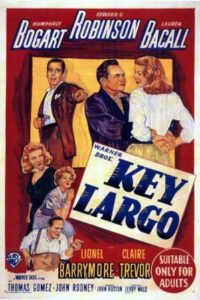“One Rocco more or less isn’t worth dying for!”——Humphrey Bogart as Frank McCloud
Gray is the prevailing, almost oppressive tone of John Huston’s Key Largo, made in 1948. In the opening, as Frank McCloud ([intlink id=”189″ type=”category”]Humphrey Bogart[/intlink]) rides the bus over the string of islands that forms the Keys, the shade of the Florida sky is an ominous gray. The claustrophobic atmosphere in the hotel in Key Largo where most of the movie takes place is, at most, varying shades of gray. And the finale, in the confrontation on a motorboat between Frank and gangster Johnny Rocco ([intlink id=”94″ type=”category”]Edward G. Robinson[/intlink]) and his gang, the sea and sky are the grayest of grays. All this in a film well suited to the chiaroscuro of black and white.
Key Largo was the fourth of six collaborations between director [intlink id=”10″ type=”category”]John Huston[/intlink] and Bogart. Their working together had begun spectacularly with The Maltese Falcon in 1942, followed by Across the Pacific. Their most recent collaboration, The Treasure of the Sierra Madre, was yet to be released when Key Largo began filming. Later would follow the two final efforts between them, The African Queen and, in 1953, Beat the Devil.
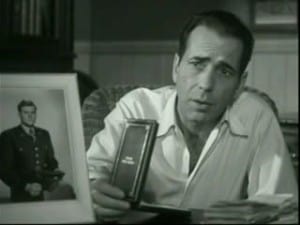 Frank McCloud is another variation on a frequent character in Bogart’s portrait gallery, the disillusioned American, who, through circumstances, is forced to stand up for what he believes—or defend those he loves—often displaying the very fervor he thought he had lost. The character is best exemplified by Rick Blaine in Casablanca and Harry Morgan in To Have and Have Not.
Frank McCloud is another variation on a frequent character in Bogart’s portrait gallery, the disillusioned American, who, through circumstances, is forced to stand up for what he believes—or defend those he loves—often displaying the very fervor he thought he had lost. The character is best exemplified by Rick Blaine in Casablanca and Harry Morgan in To Have and Have Not.
McCloud, dismayed by the horrors of World War II and that his country has tarnished the ideals for which so many died, has arrived at a rundown hotel in Key West to visit Nora Temple ([intlink id=”1521″ type=”category”]Lauren Bacall[/intlink]), the widow of an army buddy killed in the war. She, along with her wheelchair-bound father-in-law James (Lionel Barrymore), run the hotel. Frank is warmly welcomed and assures them that George died a hero’s death. He tells them where he was buried, in Cassino, on a hill near the ruins of a church.
Although it is the off-season and Nora is preparing the hotel for an approaching hurricane, five men and a woman are there, they say for the fishing. Frank meets all of them except for the one man who keeps to himself. When Johnny Rocco does appear, sitting in a bathtub, cooled by a wire-frame fan, cigar and newspaper in hand, the scene comes close—not quite, perhaps—to being one of the iconic images of Hollywood. A truly iconic scene, however, from seventeen years earlier does belong to Robinson. With a similarly named villain in Little Caesar, the actor utters that famous dying line, “Mother of Mercy! Is this the end of Rico?”
Turns out, five of the “fishing party” are gangsters—the sleazy crime boss Rocco and his four henchmen, Curly (Thomas Gomez) the most glib among them. Also, there is Rocco’s alcoholic moll Gaye (Claire Trevor). They pull guns on the Temples and Frank, planning to hold them hostage until the hurricane has passed and until some fellow criminals from Miami have arrived to buy some counterfeit money. Then they plan to escape to Cuba, using the hotel’s boat.
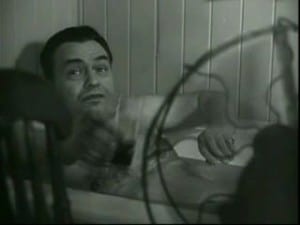 When Mr. Temple lashes out at Rocco, the gang boss taunts him, compelling Frank to come to the old man’s defense. But when Rocco offers Frank a gun and a challenge to a duel, Frank declines, saying, “One Rocco more or less isn’t worth dying for.” Soon it’s Gaye’s turn to be humiliated. Rocco insists that the woman, already drunk, sing a song if she wants another drink. After she has sung “Moanin’ Low” through her stupor and with craggy wrong notes, he refuses her the promised reward. “You were terrible,” he says. Frank gives her a drink, which further infuriates Rocco.
When Mr. Temple lashes out at Rocco, the gang boss taunts him, compelling Frank to come to the old man’s defense. But when Rocco offers Frank a gun and a challenge to a duel, Frank declines, saying, “One Rocco more or less isn’t worth dying for.” Soon it’s Gaye’s turn to be humiliated. Rocco insists that the woman, already drunk, sing a song if she wants another drink. After she has sung “Moanin’ Low” through her stupor and with craggy wrong notes, he refuses her the promised reward. “You were terrible,” he says. Frank gives her a drink, which further infuriates Rocco.
Later, a deputy sheriff (John Rodney) arrives looking for two fugitive Seminole Indians and tries to defend himself with the same gun, which proves to be unloaded, and Rocco shoots him. When the two Indians do show up, seeking the usual protection during storms that Mr. Temple always provides them, they are kept outside in the weather by Rocco. The sheriff (Monte Blue), following up on a phone call from his deputy, appears and finds his body floating in the flood water. Rocco tells him the Indians were responsible, and, finding them in a boathouse, the sheriff shoots them.
The storm over—hurricanes last longer than the one depicted—Rocco and his thugs prepare to leave for Cuba, forcing Frank to take them in a motorboat. (Although the name “Santana” appears on the stern, it is not, as often assumed, Bogart’s beloved “Santana,” which was a prize-winning yacht.) Rocco refuses to take Gaye along, and in what appears to be a desperate embrace to change his mind, she slips the gangster’s gun from his coat pocket and passes it to Frank.
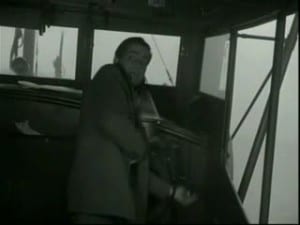 Once at sea, the Florida Straits actually, Frank is able to swerve the boat and flip one gangster (William Haade) overboard and shoot the other (Harry Lewis), though he himself is wounded. When Curly responds to the gunfire and appears from below, Frank wounds him. Curly staggers below to the remaining two gangsters and soon dies. Rocco shoots his only remaining cohort (Dan Seymour) when he refuses to go topside.
Once at sea, the Florida Straits actually, Frank is able to swerve the boat and flip one gangster (William Haade) overboard and shoot the other (Harry Lewis), though he himself is wounded. When Curly responds to the gunfire and appears from below, Frank wounds him. Curly staggers below to the remaining two gangsters and soon dies. Rocco shoots his only remaining cohort (Dan Seymour) when he refuses to go topside.
Frank is wise to Rocco’s trick of throwing on deck his supposed only gun and kills him in a brief shootout when he lunges from below with a gun. Frank radios a mayday and requests a call to the hotel to alert Nora and Mr. Temple that he is returning. (The shipboard action was an unused scene from director Howard Hawks’ To Have and Have Not, filmed four years earlier.)
Frank, the brooding antihero, is forced to act and becomes, if not a hero, then a survivor. He is already a hero—not on the boat but during the war, in that battle which had killed George. As Nora confided to Frank earlier in the film, she knew he was lying: Frank was the actual hero, not her husband.
With Bogart in his low-key role as Frank McCloud—many of his close-ups are wordless reaction shots—and Bacall as a part, with him, of the slight romantic subplot, the star performance easily shifts to Robinson. He generally resorts to his many gangster mannerisms of old, the repeated “yeah” and “see,” the gaudy egotism, the ugly grimaces and the cruelty toward others.
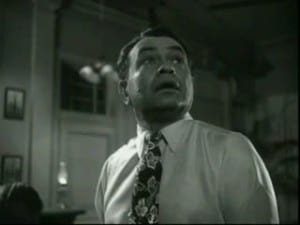 When Rocco cowers at the height of the hurricane, Robinson is at his best and, as the villain, he becomes most terrifying—terrifying because none of those watching knows what he might do. And, yes, everybody does see his fear, some incredulously so, others unsurprised. Rocco is more frightened than any one else.
When Rocco cowers at the height of the hurricane, Robinson is at his best and, as the villain, he becomes most terrifying—terrifying because none of those watching knows what he might do. And, yes, everybody does see his fear, some incredulously so, others unsurprised. Rocco is more frightened than any one else.
With dishes crashing from their shelves, pictures dropping off the walls, chandeliers swinging in the air, the lightning flashing from the windows and the wind howling, Rocco fretfully paces the floor and looks around, as if the storm is some being, an enemy about to pounce. He shouts that Mr. Temple was lying earlier about the horrors of other hurricanes and asks Curly to “say something,” to fill, in some way, the void of his fear.
In possibly the best line in the film, McCloud says, “You don’t like it, do you Rocco—the storm? Show it your gun, why don’t you? If it doesn’t stop, shoot it.”
Barrymore, wheelchair-bound in reality due to a hip injury and severe arthritis and in films since 1938, is seen being helped down a flight of stairs to the ever-ready wheelchair, which must have been highly painful for him. This member of the famous acting dynasty was often guilty of over-acting, which frequently translated to shouting, as in Key Largo. His big, exterior acting style is best exemplified in two popular Christmas associations—as the stingy banker in It’s a Wonderful Life and as Scrooge in Charles Dickens’ A Christmas Carol in radio broadcasts of the ’30s and ’40s. The grumpy exterior, it is said, hid a kind heart. He was a great uncle of Drew Barrymore.
